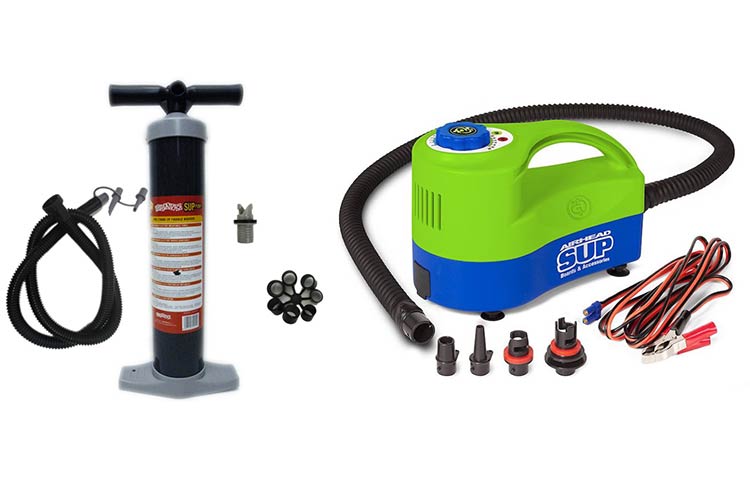How to Inflate SUP Board Correctly + Deflation Tips
Inflatable standup paddle boards are fun to have given the convenience they afford a user. You can easily deflate them and roll them up into a small size then inflate them to their full and solid sizes for some fun on the water.
Know how to inflate and deflate your iSUP is important to avoid damaging it and also provide the best experience on the water. In this guide, we look at how to inflate and deflate a stand up paddle board using both manual and electric pumps and offer other safety tips.
How to inflate a SUP
To inflate the inflatable SUP paddle board, first make sure you have a clear area to work in – typically on dry land and on a flat plane.
- Take the SUP board out of the bag and unroll it.
- Turn it on its back and remove the cap off the inflation valve.
- Press down on the stem in the center of the inflation valve then turn it in a counterclockwise direction until it comes out of the hole. It won’t come out fully but it’ll be longer on the outside. In this position, you can inflate the paddle board.
- Set up the pump in readiness for the inflation process.
- Insert the loose end of the pump into the inflation valve of the paddle board.
- Inflate the SUP board to the recommended PSI then close the inflation valve by turning the cap in a clockwise manner till its tight.
- Take the board to the water and have some fun.
For SUP boards with more than one air chamber, start at one end of the board and inflate about 7 psi (pounds per square inch). Then inflate the opposite side by alternating ½ sections until both ends are fully inflated. This should take only a minute or so with an electric pump depending on how much time it takes to cover each section. If done correctly, there will be equal pressure around all points where inflated your board in this manner.
SUP Inflation Methods
You have a choice between manual and electric pumps when inflating your SUP paddle. You may need to inflate your board more than once during the day, so a manual pump is best if you’re traveling and don’t have access to electricity. However, an electric pump will inflate much faster with less effort on your part.

Manual Pump
The first step in using a manual pump is inserting it into the valve opening at one end of the paddle board deck. The inflation end of the pump’s pipe should be inserted into the inflation valve on your board before pumping air into the board.
You’ll know when enough pressure has been reached by feeling resistance from the board. You can also use a pressure gauge to determine how much air is in the board. When the board is hard enough or the pressure gauge shows that the maximum pressure has been attained, stop adding air pressure and move onto using the board.
Electric Pump
The inflatable SUP paddle board has an inflation valve on the deck that is used for filling with air manually or by an electric pump. With an electric pump, connect it to the paddle board then to a source of power. This can be your car or house’s power outlet. Pump to the recommended PSI then use the board as desired.
Recommended Reading: Best Electric and Hand Pumps for Inflatable Stand Up Paddle Boards
How to Deflate a Paddle Board
When you’re done using your paddle board, deflate it by letting the air out. You can deflate your paddle board using a pump or you can deflate it manually with your finger.
The first thing to do is take off the straps and fins from the bottom of the board so that they don’t get in the way while deflating. To deflate, find where there are two plugs on one side of the board – these will be at either end under water level. The plug hole should be near what looks like an inflation valve stem on top.
Push down on both valves until all of the air has been released out of them – this may take some time as there’s quite a lot stored up inside. When done, replace any parts removed earlier and deflate the other side of the board.
Some paddle boards have valves which require to be pressed and moved in a counterclockwise to deflate them. After deflating your paddle board, fold it up and put it away until next time.
Inflate/Deflate Tips
Some tips to keep in mind when inflating, deflating and storing your SUP include the following:
- You should deflate the SUP board with a pump if the risk of doing it by hand is too high. The pressure from the board can damage your nails if not done right. It’s best to use an electric pump for this but you can also deflate by using a manual pump or even just sitting on it and rocking back and forth until most of the air has been released from its chambers.
- Keep water out of the inside of paddle board to attain the needed pressure and weight balance when in use. The last thing you want when trying to inflate is for those small amounts of residual water trapped in places like between fins, under side skirts, etc. They not only add weight but they’ll slow inflation down significantly as well as provide unwanted moisture for the deflated board.
- Place the paddle board on a flat surface when inflating it. This ensures even inflation throughout every inch of the vessel without any areas being over inflated and others underinflated.
- Always rinse the paddle board after each use to remove any types of dirt and salt that might corrode it and reduce its longevity.
- When washing the paddle board, avoid using harsh chemicals or solvents. These can damage the paddle board, deflate it and take away its shape.
- After you rinse your paddle board, air dry it completely before you store it.
- Provide the right conditions when storing your paddle board:
- Store the paddle board either inflated or deflated.
- Place your paddle board in a cool, dry place away from direct sunlight and moisture. Heat and moisture can damage paddle board.
- Keep the pump handy because you will need to inflate the paddle board before use if you store it deflated.
- When storing your paddle board, avoid placing heavy objects on it. You want to keep your paddle board balanced and weighted evenly on both sides so that the valves do not deflate due to pressure.
- When deflating a paddle board, use caution as you could cause damage if using too much air pressure or popping an inflatable SUP with a sharp object such as scissors or fingernails. The best way is through gentle release of air from the valve by slowly turning the screw counterclockwise after unscrewing the lever nut (left-hand thread) located at end opposite pump connector cap. Turn knob until there’s about ½” left before deflated form touches ground then stop.
With these tips, you can be sure of having a long life of use for the paddle board. As long as you take care of it, your days on the water will always be happy and safe.
Can I keep my inflatable sup inflated?
The choice as to whether you should keep your paddle board inflated or deflated depends on how you plan to store it. If you have space and time, deflating it is the best option for storing your board because this will help preserve its shape.
However, if you don’t have adequate space or enough time to deflate your paddle board before storage then inflating it might be a better option for preserving its shape while in-between uses. But remember that inflatable SUPs are not designed to last as long as hard boards so make sure they stay inflated according to their use schedule.
Keeping the paddle board when inflated
The advantages of keeping your paddle board when it’s inflated are as follows:
- It also won’t develop deep creases especially if you’re keeping the board for a long time. Overtime, paddle boards will develop creases when stored for too long in a deflated and folded manner.
- It’ll also be ready for use each time you want to use it. No need to inflate it first.
If you decide against inflating your paddle board then there are still other precautions that should be taken such as checking over time for leaks and using a waterproof cover when stored outside.
Keeping the paddle board when deflated
The benefits of keeping a paddle board when it’s deflated include:
- It takes up less space than when inflated. This is a great option for those who don’t have many storage options at home or want to take their paddle board with them on vacations. A paddle board deflates to a smaller size for more efficient transport and storage in your vehicle or home. You can deflate the board after use, store it somewhere safe such as under the bed or on top of an airtight container, then inflate it when you want to use it again.
- Storing the board deflated also saves money by not needing inflation equipment all year round; only during those times when you plan to go out paddling with your deflated surfboard.
- Deflating your paddle board after use is also beneficial as it will help extend the life of your inflatable SUP by preventing damage from major pressure changes during transport and storage. This means that if your deflated sup has been stored for some time without being inflated again, then you should still be able to inflate it with minimal effort needed on the part of our deflator pump.
As such, when using an inflatable SUP, always keep in mind the benefits and downsides of storing it both when deflated or inflated. If you don’t have your own pump, better store them inflated since you never know when you’ll find the pump to use for their inflation. The good news is that the paddle board holds air for a long time hence can stay inflated for long without losing its shape and functionality.
How much do you inflate SUP?
You should inflate your SUP to the recommended PSI written on the board. A majority of iSUPs can be inflated to between 10 PSI and 15 PSI. The higher the PSI, the better the board is at high-performance activities such as surfing waves and paddle boarding on turbulent water.
How long will an inflatable Stand Up Paddle Board stay inflated after inflation?
An inflatable stand up paddle board can stay inflated for up to a year without a significant change in its sturdiness. For example, when inflated to the maximum recommended PSI, the board might only lose 1 or 2 PSI units after 10 months.
Some aspects which determine how long the body will stay inflated include the following:
- The storage conditions: if stored in cool and dry conditions, the board won’t lose pressure as much as when it’s stored in a hot area. The expansion and contraction experienced in hot and cold areas will affect its final PSI when taken out of storage.
- The frequency of use: if the board isn’t used much, it’ll stay in a steady condition where it won’t lose its pressure.
- Quality of paddle board: those of a high quality will keep pressure for longer than the weaker ones.
- The PSI rating: boards with a higher PSI rating will generally retain more of their pressure for longer periods than those with lower PSI ratings. A higher PSI rating also means that the board has a higher quality to retain the pressure in it.
Knowing how to inflate, deflate and store your SUP is a good way to keep it in good condition. This way, it’ll serve you for longer while providing a safe user experience.







